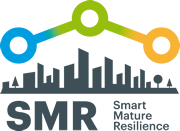Resources
PUBLICATIONS AND DOWNLOADS
Design principles to promote transdisciplinary collaboration
Date
Deliverable
31/05/2016
D4.2
Lead Partner
CIEM, University of Agder
Authors
Tim A. Majchrzak and Mihoko Sakurai (CIEM, University of Agder)
Deliverable 4.2 is the second of four deliveries in Work Package 4 (WP4). The work package runs from month one to month 18 with a deliverable being due each six months. The overall goal is to build a collaborative environment in order to facilitate awareness and engagement among key partner in resilience building. Ultimately, this leads to the development of an integrated Resilience Information Portal, which will be used beyond WP4 for the remainder of the project.
This second deliverable is interlinked with the work in other deliverables. In particularly, it provides input for WP5, which took up activities during the work towards D4.2. Similar to D4.1, the deliverable report reflects the twofold nature of WP4: It contains both domain-specific and technologically-driven sections. It makes heavy use of the insights presented in D4.1 but at the same time introduces a host of results from the work of the last six months.
D4.2 compiles design principles for the use of social networking services to promote transdisciplinary collaboration. It does so based on a series of extensive interviews with the CITIES and stakeholders. Interviews were done in a semi-structured fashion and we allowed for open discussion. This enabled us to gain broad insights from the work with the city partners.
To understand challenges in the communication activities of the CITIES, we first needed to understand how they communicate. Thus, core communication activities have been identified for the city partners. Along with these, we have compiled quotes from cities and their stakeholders that hint to a variety of challenges of short-term and long-term communication. In particular, cities need to deal with unintegrated communication tools, information fragmentation (including incompatibility of information), logging incident information, presenting information on complex emergencies, lack of updating what others are doing, lack of direct communication, raising awareness of potential and real threats among the citizens, lack of information variety, unawareness of information reach, contacting relevant people quickly, communicating with hard to reach groups (e.g. people who do not speak local language), human resource updating, lack of interactive communication, long-term involvement, security, information confidentiality, handling of documents marked as protected or confidential, mal-information on social media, and managing social media.
The challenges lead to six design goals for a Resilience Information Portal: Information Sharing (on daily-basis and for emergencies), Establish a Communication Structure, Citizen Involvement and Raising Awareness, Knowledge Sharing (locally, nationally, and on the European level), Information Sovereignty, and Usability. Information Provision (in general, to local stakeholders, and to citizens) is set as an enabling principle especially for the design goals of Establish a Communication Structure and Citizen Involvement and Raising Awareness. The six goals are extensively motivated and can be directly linked to input from the cities. For each design goal, several design principles could be identified.
While the design goals and principles take an abstract, high-level perspective that allows generalization, actual development activities require a low-level view with an interface to the technological ramifications. Therefore, we present a functional specification. The specification contains a set of criteria for the Resilience Information Portal. They are linked to the design goals and principles and are based on the interview work as well. The functional specification serves as the foundation for the actual development activities (which will lead to D4.4) as well as the ongoing work on design principles (which will lead to D4.3). Consequently, the deliverable report closes with a short look at the onward journey of the work package.

This project has received funding from the European Union’s Horizon 2020 research and innovation programme under grant agreement no. 653569.

